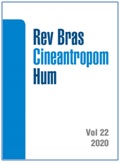Association between body composition and aerobic capacity in karate athletes
DOI:
https://doi.org/10.1590/1980-0037.2020v22e71989Abstract
The aim of this study was to analyze the association between body composition and performance in the karate specific aerobic test (KSAT). This is a study carried out with thirteen athletes (6 females) with a mean age of 20.7 ± 4.2 years, affiliated to the Pernambuco Federation of Karate Associations, were developing this training routine during the 2018 season. Body mass and height were measured. To measure body composition, the body densitometry method was used by the x-ray double-ray absorptiometry (DEXA) technique. Karate Specific Aerobic Test was used to verify aerobic performance. Association analyzes were performed between body composition variables and KSAT performance using Pearson's correlation test and linear regression. All analyzes adopted a significance of p <0.05. KSAT performance was negatively correlated with total fat mass (r = -0.797; p = 0.001) and fat percentage (r = -0.757; p = 0.003). The linear regression model with the highest explanatory power included total fat and KSAT (adjusted R² = 0.732; p <0.001) exhibited a negative association with total fat (? = -0.21; p <0.001), and the model that included % body fat and KSAT (adjusted R² = 0.708; p = 0.003) were negatively associated with% body fat (? = -22.937; p = 0.001), both adjusted for gender and age. There is a negative association between total fat mass, body fat percentage and karate specific aerobic test performance.
References
Beekley MD, Abe T, Kondo M, Midorikawa T, Yamauchi T. Comparison of normalized maximum aerobic capacity and body composition of sumo wrestlers to athletes in combat and other sports. J Sports Sci Med 2006;5(CSSI):13-20.
Vanhees L, Lefevre J, Philippaerts R, Martens M, Huygens W, Troosters T, et al. How to assess physical activity? How to assess physical fitness? Eur J Cardiovasc Prev Rehabil 2005;12(2):102-14.
Boileau RA, Horswill CA. Body composition in sports: Measurement and applications for weight loss and gain. Exerc Sport Sci 2000:319-38.
Bertini I, Pujia A, Giampietro M. A follow-up study of the variations in the body composition of karate athletes. Acta Diabetol 2003;40 Suppl 1:S142-4.
Oppliger RA, Utter AC, Scott JR, Dick RW, Klossner D. NCAA rule change improves weight loss among national championship wrestlers. Med Sci Sports Exerc 2006;38(5):963-70.
World Karate Federation. New Kata and Kumite Rules. WKF: France. 2018; Available from: https://www.wkf.net/pdf/WKFCompetitionRules2018.pdf [2019 Aug 10].
Roschel H, Batista M, Monteiro R, Bertuzzi RC, Barroso R, Loturco I, et al. Association between neuromuscular tests and kumite performance on the Brazilian Karate National Team. J Sports Sci Med 2009;8(CSSI3):20-4.
Layton C. Reaction+ movement-time and sidedness in shotokan karate students. Percept Mot Skills 1993;76(3 Pt 1):765-6.
Fontani G, Lodi L, Felici A, Migliorini S, Corradeschi F. Attention in athletes of high and low experience engaged in different open skill sports. Percept Mot Skills 2006;102(3):791-805.
Chaabene H, Hachana Y, Franchini E, Mkaouer B, Chamari K. Physical and physiological profile of elite karate athletes. Sports Med 2012;42(10):829-43.
Giampietro M, Pujia A, Bertini I. Anthropometric features and body composition of young athletes practicing karate at a high and medium competitive level. Acta Diabetol 2003;40(1):s145-s8.
Beneke R, Beyer T, Jachner C, Erasmus J, Hütler M. Energetics of karate kumite. Eur J Appl Physiol 2004;92(4-5):518-23.
Doria C, Veicsteinas A, Limonta E, Maggioni MA, Aschieri P, Eusebi F, et al. Energetics of karate (kata and kumite techniques) in top-level athletes. Eur J Appl Physiol 2009;107(5):603-10.
Nunan D. Development of a sports specific aerobic capacity test for karate-a pilot study. J Sports Sci Med 2006;5(CSSI):47-53.
Chaabène H, Hachana Y, Franchini E, Mkaouer B, Montassar M, Chamari K. Reliability and construct validity of the karate-specific aerobic test. J Strength Cond Res 2012;26(12):3454-60.
Tabben M, Coquart J, Chaabène H, Franchini E, Chamari K, Tourny C. Validity and reliability of new karate-specific aerobic test for karatekas. Int J Sports Physiol Perform 2014;9(6):953-8.
Stewart A, Marfell-Jones MJ, Olds T, De Ridder H. International standards for anthropometric assessment. Lower Hutt, New Zealand : International Society for the Advancement of Kinanthropometry; 2011.
Krugh M, Langaker MD. Dual Energy Xray Absorptiometry (DEXA). StatPearls Publishing; United States. 2018; Available from: https://www.ncbi.nlm.nih.gov/books/NBK519042/ [2019 Aug 09].
Mcardle WD, Katch FI, Katch VL. Fisiologia do exercício: nutrição, energia e desempenho humano. 7ª ed. Rio Janeiro: Guanabara Koogan; 2011.
Chaabène H, Hachana Y, Attia A, Mkaouer B, Chaabouni S, Chamari K. Relative and Absolute Reliability of Karate Specific Aerobic Test (Ksat) in Experienced Male Athletes. Biol Sport 2012;29(3):211-215.
Chaabene H. Karate kumite: how to optimize performance. Physical Determinants of Karate Kumite. OMICS; United States. 2015; Available from: https://www.researchgate.net/publication/291693868_Karate_kumite_how_to_optimize_performance [2019 Aug 06].
Imamura H, Yoshimura Y, Uchida K, Nishimura S, Nakazawa AT. Maximal oxygen uptake, body composition and strength of highly competitive and novice karate practitioners. Appl Human Sci 1998;17(5):215-8.



